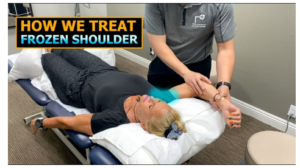Frozen Shoulder Therapy: Exploring Effective Treatment Options
Frozen shoulder (adhesive capsulitis) is a condition marked by stiffness, pain, and limited range of motion in the shoulder joint. Effective therapy is essential for managing this condition, as it helps reduce pain, restore mobility, and enhance quality of life. Various therapy options are available, including physical therapy, alternative therapies, and home remedies. In this article, we will explore the most effective therapies for frozen shoulder, their benefits, and how they contribute to the recovery process.
Physical Therapy for Frozen Shoulder
Physical therapy plays a crucial role in the treatment of frozen shoulder. It focuses on improving range of motion, reducing pain, and preventing further stiffness. Physical therapy for frozen shoulder includes specific exercises designed to stretch and strengthen the shoulder joint, enabling patients to regain normal shoulder function over time.
- Key Exercises in Physical Therapy
- Stretching Exercises: These exercises aim to improve flexibility and reduce stiffness in the shoulder. For example, pendulum swings, wall climbs, and external rotation stretches are commonly used to gently increase shoulder movement.
- Strengthening Exercises: As mobility improves, strengthening exercises such as rotator cuff strengthening help rebuild the muscles around the shoulder to provide better support and prevent future injuries.
- Range-of-Motion Exercises: These exercises, including passive and active movements, help the shoulder joint regain its full range of motion. Examples include arm raises and shoulder rotations.
Physical therapy is often the first-line treatment for frozen shoulder, and its success greatly depends on consistency and adherence to the prescribed exercises.
Home Therapy for Frozen Shoulder
While physical therapy is important for rehabilitation, home therapy plays a significant role in managing symptoms and improving mobility. Individuals can perform gentle exercises at home to complement professional therapy.
- Effective Home Therapy Techniques
- Heat and Cold Packs: Applying heat can help relax tight muscles and improve blood flow, while cold packs reduce inflammation and relieve pain. Alternating between hot and cold compresses can be effective in the initial stages of frozen shoulder.
- Gentle Stretches: Performing gentle stretches at home, such as shoulder rolls and arm stretches, can help maintain joint flexibility and prevent further stiffness.
- Rest and Activity Modification: Avoiding activities that stress the shoulder and taking frequent breaks can help manage symptoms, especially during flare-ups.
Alternative Therapies for Frozen Shoulder
In addition to physical therapy, several alternative therapies can be beneficial for managing frozen shoulder symptoms, especially when conventional treatments are insufficient.
- Acupuncture Therapy for Frozen Shoulder
Acupuncture involves inserting thin needles into specific points of the body to stimulate the nervous system and promote healing. For frozen shoulder, acupuncture may help:
- Reduce inflammation: Acupuncture can stimulate blood flow and promote the body’s natural anti-inflammatory processes.
- Relieve pain: By releasing endorphins, acupuncture may offer pain relief without the need for medication.
- Improve mobility: Acupuncture may help restore normal range of motion by addressing muscle tightness and joint stiffness.
- Bowen Therapy for Frozen Shoulder
Bowen Therapy is a form of manual therapy that involves gentle movements over specific muscle groups to stimulate the body’s self-healing processes. For frozen shoulder, Bowen therapy can help by:
- Relaxing tight muscles around the shoulder.
- Increasing circulation, which aids in healing.
- Reducing pain and inflammation associated with frozen shoulder.
Bowen therapy is often used as a complementary treatment alongside physical therapy.
- Cupping Therapy for Frozen Shoulder
Cupping therapy involves placing cups on the skin to create suction, which can improve circulation and relieve muscle tension. For frozen shoulder, cupping may:
- Enhance blood flow to the affected area.
- Reduce stiffness and pain by loosening tight muscles.
- Promote relaxation and reduce stress in the shoulder joint.
Massage Therapy for Frozen Shoulder
Massage therapy is an effective treatment for reducing muscle tension, promoting blood flow, and improving flexibility in individuals with frozen shoulder. Types of massage that can benefit frozen shoulder patients include:
- Deep Tissue Massage: Helps release tension in the muscles and fascia surrounding the shoulder joint.
- Swedish Massage: A lighter technique that can promote relaxation and reduce stress.
- Trigger Point Therapy: Targets specific “knots” or trigger points in the muscles that may contribute to stiffness and pain.
Massage therapy can be incorporated as part of a comprehensive treatment plan to improve shoulder mobility and reduce discomfort.
Best Therapy for Frozen Shoulder: A Comprehensive Approach
While there is no one-size-fits-all solution, a combination of physical therapy, home therapy, and alternative treatments often works best for managing frozen shoulder. The best therapy plan will vary depending on the severity of the condition, individual preferences, and how the body responds to treatment.
Incorporating Curapod: An effective adjunct therapy for managing frozen shoulder symptoms is Curapod. Curapod uses electrical stimulation to relax muscles, reduce inflammation, and promote healing in the shoulder joint. It is especially beneficial when combined with physical therapy and alternative treatments like acupuncture or massage therapy, as it can accelerate recovery and improve mobility. Curapod can be used for pain relief, muscle relaxation, and improved circulation, making it a versatile tool for managing frozen shoulder at any stage of recovery.
References (Cardiff Harvard Style)
- Mayo Clinic, 2025. Frozen Shoulder: Symptoms and Causes. Available at: https://www.mayoclinic.org/diseases-conditions/frozen-shoulder/diagnosis-treatment/drc-20370892 [Accessed 28 February 2025].
- American Academy of Orthopaedic Surgeons (AAOS), 2025. Frozen Shoulder: Symptoms, Causes, and Treatment. Available at: https://www.aaos.org/diseases–conditions/frozen-shoulder/ [Accessed 28 February 2025].
- Spine-Health, 2025. Frozen Shoulder Treatment and Exercises. Available at: https://www.spine-health.com/conditions/shoulder-pain/frozen-shoulder [Accessed 28 February 2025].


